| Welcome
To Our "Selected Works of Kurt Saxon & Other Fine Folk" Section |
This
is why I fear an EMP attack against the United States.
Read and heed!

![]()
E-Bombs
Part 1
of 4
In
the blink of an eye, electromagnetic bombs could throw civilization back 200
years. And terrorists can build them for $400.
BY
JIM WILSON
Lead illustration by Edwin Herder
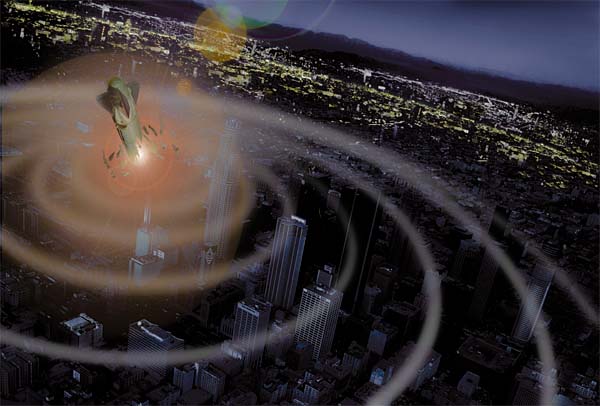
The
next Pearl Harbor
will not announce itself with a searing flash of nuclear light or with the
plaintive wails of those dying of Ebola or its genetically engineered twin. You
will hear a sharp crack in the distance. By the time you mistakenly identify
this sound as an innocent clap of thunder, the civilized world will have become
unhinged. Fluorescent lights and television sets will glow eerily bright,
despite being turned off. The aroma of ozone mixed with smoldering plastic will
seep from outlet covers as electric wires arc and telephone lines melt. Your
Palm Pilot and MP3 player will feel warm to the touch, their batteries
overloaded. Your computer, and every bit of data on it, will be toast. And then
you will notice that the world sounds different too. The background music of
civilization, the whirl of internal-combustion engines, will have stopped. Save
a few diesels, engines will never start again. You, however, will remain
unharmed, as you find yourself thrust backward 200 years, to a time when
electricity meant a lightning bolt fracturing the night sky. This is not a
hypothetical, son-of-Y2K scenario. It is a realistic assessment of the damage
the Pentagon believes could be inflicted by a new generation of
weapons—E-bombs.
The
first major test of an American electromagnetic bomb is scheduled for next year.
Ultimately, the Army hopes to use E-bomb technology to explode artillery shells
in midflight. The Navy wants to use the E-bomb’s high-power microwave pulses
to neutralize antiship missiles. And, the Air Force plans to equip its bombers,
strike fighters, cruise missiles and unmanned aerial vehicles with E-bomb
capabilities. When fielded, these will be among the most technologically
sophisticated weapons the U.S. military establishment has ever built.
There
is, however, another part to the E-bomb story, one that military planners are
reluctant to discuss. While American versions of these weapons are based on
advanced technologies, terrorists could use a less expensive, low-tech approach
to create the same destructive power. “Any nation with even a 1940s technology
base could make them,” says Carlo Kopp, an Australian-based expert on
high-tech warfare. “The threat of E-bomb proliferation is very real.”
POPULAR MECHANICS estimates a basic weapon could be built for $400.
An
Old Idea Made New
The theory behind the E-bomb was proposed in 1925 by physicist Arthur H.
Compton—not to build weapons, but to study atoms. Compton demonstrated that
firing a stream of highly energetic photons into atoms that have a low atomic
number causes them to eject a stream of electrons. Physics students know this
phenomenon as the Compton Effect. It became a key tool in unlocking the secrets
of the atom.
Ironically,
this nuclear research led to an unexpected demonstration of the power of the
Compton Effect, and spawned a new type of weapon. In 1958, nuclear weapons
designers ignited hydrogen bombs high over the Pacific Ocean. The detonations
created bursts of gamma rays that, upon striking the oxygen and nitrogen in the
atmosphere, released a tsunami of electrons that spread for hundreds of miles.
Street lights were blown out in Hawaii and radio navigation was disrupted for 18
hours, as far away as Australia. The United States set out to learn how to
“harden” electronics against this electromagnetic pulse (EMP) and develop
EMP weapons.
America
has remained at the forefront of EMP weapons development. Although much of this
work is classified, it’s believed that current efforts are based on using
high-temperature superconductors to create intense magnetic fields. What worries
terrorism experts is an idea the United States studied but discarded—the Flux
Compression Generator (FCG).
A
Poor Man’s E-Bomb
An FCG is an astoundingly simple weapon. It consists of an explosives-packed
tube placed inside a slightly larger copper coil, as shown below. The instant
before the chemical explosive is detonated, the coil is energized by a bank of
capacitors, creating a magnetic field. The explosive charge detonates from the
rear forward. As the tube flares outward it touches the edge of the coil,
thereby creating a moving short circuit. “The propagating short has the effect
of compressing the magnetic field while reducing the inductance of the stator
[coil],” says Kopp. “The result is that FCGs will produce a ramping current
pulse, which breaks before the final disintegration of the device. Published
results suggest ramp times of tens of hundreds of microseconds and peak currents
of tens of millions of amps.” The pulse that emerges makes a lightning bolt
seem like a flashbulb by comparison.
An
Air Force spokesman, who describes this effect as similar to a lightning strike,
points out that electronics systems can be protected by placing them in metal
enclosures called Faraday Cages that divert any impinging electromagnetic energy
directly to the ground. Foreign military analysts say this reassuring
explanation is incomplete.
The
India Connection
The Indian military has studied FCG devices in detail because it fears that
Pakistan, with which it has ongoing conflicts, might use E-bombs against the
city of Bangalore, a sort of Indian Silicon Valley. An Indian Institute for
Defense Studies and Analysis study of E-bombs points to two problems that have
been largely overlooked by the West. The first is that very-high-frequency
pulses, in the microwave range, can worm their way around vents in Faraday
Cages. The second concern is known as the “late-time EMP effect,” and may be
the most worrisome aspect of FCG devices. It occurs in the 15 minutes after
detonation. During this period, the EMP that surged through electrical systems
creates localized magnetic fields. When these magnetic fields collapse, they
cause electric surges to travel through the power and telecommunication
infrastructure. This string-of-firecrackers effect means that terrorists would
not have to drop their homemade E-bombs directly on the targets they wish to
destroy. Heavily guarded sites, such as telephone switching centers and
electronic funds-transfer exchanges, could be attacked through their electric
and telecommunication connections.
Knock out electric power, computers and telecommunication and you’ve destroyed the foundation of modern society. In the age of Third World-sponsored terrorism, the E-bomb is the great equalizer.
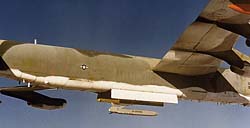
In the 1980s, the Air Force tested E-bombs that used cruise-missile delivery systems. PHOTO BY AVIATION WEEK & AEROSPACE TECHNOLOGY
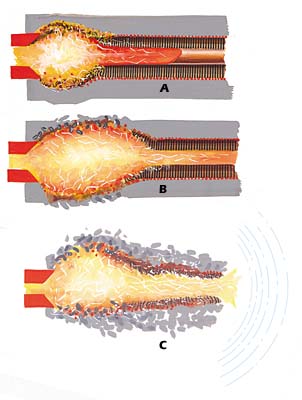
To ignite an E-bomb, a starter current energizes the stator coil, creating a magnetic field. The explosion (A) expands the tube, short-circuiting the coil and compressing the magnetic field forward (B). The pulse is emitted (C) at high frequencies that defeat protective devices like Faraday Cages.
ILLUSTRATIONS BY JOHN BATCHELOR
![]()
ELECTROMAGNETIC
BOMB
A
WEAPON OF ELECTRONIC MASS DESTRUCTION
WRITTEN
BY CARLO KOPP, DEFENSE ANALYST, MELBOURNE, AUSTRALIA
High
Power Electromagnetic Pulse generation techniques and High Power Microwave
technology have matured to the point where practical E-bombs (Electromagnetic
bombs) are becoming technically feasible, with new applications in both
Strategic and Tactical Information Warfare. The development of conventional
E-bomb devices allows their use in non-nuclear confrontations. This paper
discusses aspects of the technology base, weapon delivery techniques and
proposes a doctrinal foundation for the use of such devices in warhead and bomb
applications.
Introduction
The
prosecution of a successful Information Warfare (IW) campaign against an
industrialised or post industrial opponent will require a suitable set of tools.
As demonstrated in the Desert Storm air campaign, air power has proven to be a
most effective means of inhibiting the functions of an opponent’s vital
information processing infrastructure. This is because air power allows
concurrent or parallel engagement of a large number of targets over
geographically significant areas.
While
Desert Storm demonstrated that the application of air power was the most
practical means of crushing an opponent’s information processing and
transmission nodes, the need to physically destroy these with guided munitions
absorbed a substantial proportion of available air assets in the early phase of
the air campaign. Indeed, the aircraft capable of delivering laser guided bombs
were largely occupied with this very target set during the first nights of the
air battle.
The
efficient execution of an IW campaign against a modern industrial or
post-industrial opponent will require the use of specialised tools designed to
destroy information systems. Electromagnetic bombs built for this purpose can
provide, where delivered by suitable means, a very effective tool for this
purpose.
The
EMP Effect
The
ElectroMagnetic Pulse (EMP) effect was first observed during the early testing
of high altitude airburst nuclear weapons. The effect is characterised by the
production of a very short (hundreds of nanoseconds) but intense electromagnetic
pulse, which propagates away from its source with ever diminishing intensity,
governed by the theory of electromagnetism. The ElectroMagnetic Pulse is in
effect an electromagnetic shock wave.
This
pulse of energy produces a powerful electromagnetic field, particularly within
the vicinity of the weapon burst. The field can be sufficiently strong to
produce short lived transient voltages of thousands of Volts (i.e. kiloVolts) on
exposed electrical conductors, such as wires, or conductive tracks on printed
circuit boards, where exposed.
It
is this aspect of the EMP effect which is of military significance, as it can
result in irreversible damage to a wide range of electrical and electronic
equipment, particularly computers and radio or radar receivers. Subject to the
electromagnetic hardness of the electronics, a measure of the equipment’s
resilience to this effect, and the intensity of the field produced by the
weapon, the equipment can be irreversibly damaged or in effect electrically
destroyed. The damage inflicted is not unlike that experienced through exposure
to close proximity lightning strikes, and may require complete replacement of
the equipment, or at least substantial portions thereof.
Commercial
computer equipment is particularly vulnerable to EMP effects, as it is largely
built up of high density Metal Oxide Semiconductor (MOS) devices, which are very
sensitive to exposure to high voltage transients. What is significant about MOS
devices is that very little energy is required to permanently wound or destroy
them, any voltage in typically in excess of tens of Volts can produce an effect
termed gate breakdown which effectively destroys the device. Even if the pulse
is not powerful enough to produce thermal damage, the power supply in the
equipment will readily supply enough energy to complete the destructive process.
Wounded devices may still function, but their reliability will be seriously
impaired. Shielding electronics by equipment chassis provides only limited
protection, as any cables running in and out of the equipment will behave very
much like antennae, in effect guiding the high voltage transients into the
equipment.
Computers
used in data processing systems, communications systems, displays, industrial
control applications, including road and rail signalling, and those embedded in
military equipment, such as signal processors, electronic flight controls and
digital engine control systems, are all potentially vulnerable to the EMP
effect.
Other
electronic devices and electrical equipment may also be destroyed by the EMP
effect. Telecommunications equipment can be highly vulnerable, due to the
presence of lengthy copper cables between devices. Receivers of all varieties
are particularly sensitive to EMP, as the highly sensitive miniature high
frequency transistors and diodes in such equipment are easily destroyed by
exposure to high voltage electrical transients. Therefore radar and electronic
warfare equipment, satellite, microwave, UHF, VHF, HF and low band
communications equipment and television equipment are all potentially vulnerable
to the EMP effect.
It
is significant that modern military platforms are densely packed with electronic
equipment, and unless these platforms are well hardened, an EMP device can
substantially reduce their function or render them unusable.
The
Technology Base for Conventional Electromagnetic Bombs
The
technology base which may be applied to the design of electromagnetic bombs is
both diverse, and in many areas quite mature. Key technologies which are extant
in the area are explosively pumped Flux Compression Generators (FCG), explosive
or propellant driven Magneto-Hydrodynamic (MHD) generators and a range of HPM
devices, the foremost of which is the Virtual Cathode Oscillator or Vircator. A
wide range of experimental designs have been tested in these technology areas,
and a considerable volume of work has been published in unclassified literature.
This paper will review the basic principles and attributes of these technologies, in relation to bomb and warhead applications. It is stressed that this treatment is not exhaustive, and is only intended to illustrate how the technology base can be adapted to an operationally deployable capability.
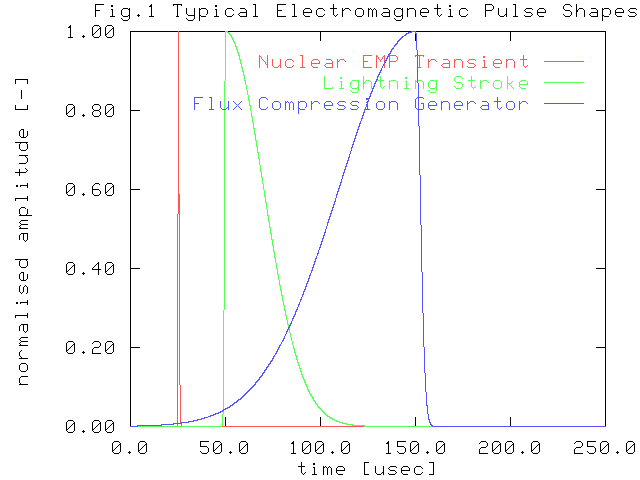
Explosively
Pumped Flux Compression Generators
The
explosively pumped FCG is the most mature technology applicable to bomb designs.
The FCG was first demonstrated by Clarence Fowler at Los Alamos National
Laboratories (LANL) in the late fifties. Since that time a wide range of FCG
configurations has been built and tested, both in the US and the USSR, and more
recently CIS.
The
FCG is a device capable of producing electrical energies of tens of MegaJoules
in tens to hundreds of microseconds of time, in a relatively compact package.
With peak power levels of the order of TeraWatts to tens of TeraWatts, FCGs may
be used directly, or as one shot pulse power supplies for microwave tubes. To
place this in perspective, the current produced by a large FCG is between ten to
a thousand times greater than that produced by a typical lightning stroke.
The
central idea behind the construction of FCGs is that of using a fast explosive
to rapidly compress a magnetic field, transferring much energy from the
explosive into the magnetic field.
The
initial magnetic field in the FCG prior to explosive initiation is produced by a
start current. The start current is supplied by an external source, such a high
voltage capacitor bank (Marx bank), a smaller FCG or an MHD device. In
principle, any device capable of producing a pulse of electrical current of the
order of tens of kiloAmperes to MegaAmperes will be suitable.
A number of geometrical configurations for FCGs have been published. The most commonly used arrangement is that of the coaxial FCG. The coaxial arrangement is of particular interest in this context, as its essentially cylindrical form factor lends itself to packaging into munitions.
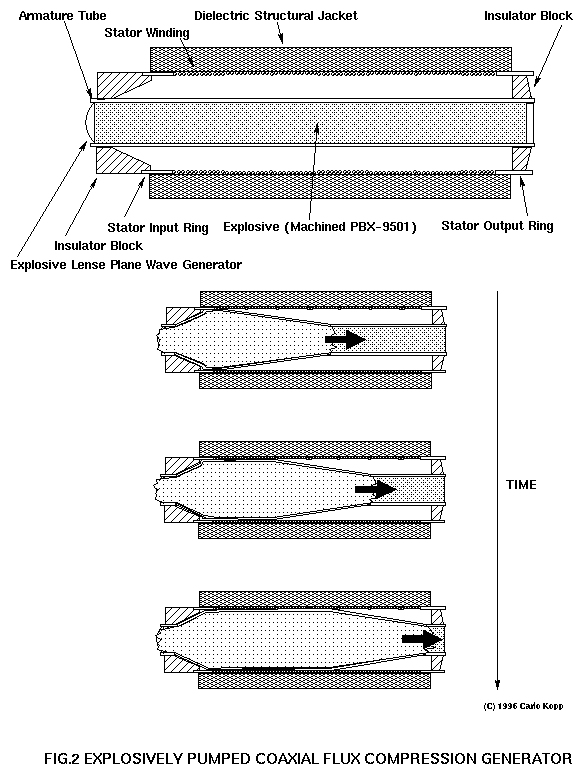
n
a typical coaxial FCG , a cylindrical copper tube forms the armature. This tube
is filled with a fast high energy explosive. A number of explosive types have
been used, ranging from B and C-type compositions to machined blocks of
PBX-9501. The armature is surrounded by a helical coil of heavy wire, typically
copper, which forms the FCG stator. The stator winding is in some designs split
into segments, with wires bifurcating at the boundaries of the segments, to
optimise the electromagnetic inductance of the armature coil.
The
intense magnetic forces produced during the operation of the FCG could
potentially cause the device to disintegrate prematurely if not dealt with. This
is typically accomplished by the addition of a structural jacket of a
non-magnetic material. Materials such as concrete or Fibreglass in an Epoxy
matrix have been used. In principle, any material with suitable electrical and
mechanical properties could be used. In applications where weight is an issue,
such as air delivered bombs or missile warheads, a glass or Kevlar Epoxy
composite would be a viable candidate.
It
is typical that the explosive is initiated when the start current peaks. This is
usually accomplished with a explosive lense plane wave generator which produces
a uniform plane wave burn (or detonation) front in the explosive. Once
initiated, the front propagates through the explosive in the armature,
distorting it into a conical shape (typically 12 to 14 degrees of arc). Where
the armature has expanded to the full diameter of the stator, it forms a short
circuit between the ends of the stator coil, shorting and thus isolating the
start current source and trapping the current within the device. The propagating
short has the effect of compressing the magnetic field, whilst reducing the
inductance of the stator winding. The result is that such generators will
producing a ramping current pulse, which peaks before the final disintegration
of the device. Published results suggest ramp times of tens to hundreds of
microseconds, specific to the characteristics of the device, for peak currents
of tens of MegaAmperes and peak energies of tens of MegaJoules.
The
current multiplication (i.e.. ratio of output current to start current) achieved
varies with designs, but numbers as high as 60 have been demonstrated. In a
munition application, where space and weight are at a premium, the smallest
possible start current source is desirable. These applications can exploit
cascading of FCGs, where a small FCG is used to prime a larger FCG with a start
current. Experiments conducted by LANL and AFWL have demonstrated the viability
of this technique.
The
principal technical issues in adapting the FCG to weapons applications lie in
packaging, the supply of start current, and matching the device to the intended
load. Interfacing to a load is simplified by the coaxial geometry of coaxial and
conical FCG designs. Significantly, this geometry is convenient for weapons
applications, where FCGs may be stacked axially with devices such a microwave
Vircators. The demands of a load such as a Vircator, in terms of waveform shape
and timing, can be satisfied by inserting pulse shaping networks, transformers
and explosive high current switches.
Explosive
and Propellant Driven MHD Generators
The
design of explosive and propellant driven Magneto-Hydrodynamic generators is a
much less mature art that that of FCG design. Technical issues such as the size
and weight of magnetic field generating devices required for the operation of
MHD generators suggest that MHD devices will play a minor role in the near term.
In the context of this paper, their potential lies in areas such as start
current generation for FCG devices.
The
fundamental principle behind the design of MHD devices is that a conductor
moving through a magnetic field will produce an electrical current transverse to
the direction of the field and the conductor motion. In an explosive or
propellant driven MHD device, the conductor is a plasma of ionised explosive or
propellant gas, which travels through the magnetic field. Current is collected
by electrodes which are in contact with the plasma jet.
The
electrical properties of the plasma are optimized by seeding the explosive or
propellant with suitable additives, which ionizes during the burn. Published
experiments suggest that a typical arrangement uses a solid propellant gas
generator, often using conventional ammunition propellant as a base. Cartridges
of such propellant can be loaded much like artillery rounds, for multiple shot
operation.
![]()
